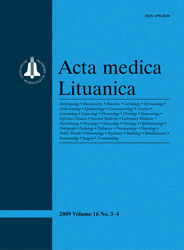Acta medica Lituanica
 ISSN 1392-0138 ISSN 2029-4174 (online) |
2011 m. Nr. 3 Botulinum toxin therapy for nonneurogenic overactive bladder: first experience
The paper presents early experience in the treatment of 20 patients with botulinum toxin injections into the detrusor muscle for the treatment of non-neurogenic overactive bladder (OAB) resistant to anticholinergic drugs.
Background. Botulinum toxin, a presynaptic neuromuscular blocking agent, reduces the involuntary bladder contractions that cause urgency, frequency and urge incontinence. We present our early experience with Dysport® injections into the detrusor for the treatment of non–neurogenic overactive bladder (OAB) resistant to anticholinergic drugs. Materials and methods. Using intravenous anaesthesia, 20 patients (18 female and 2 male) with non-neurogenic OAB were injected with botulinum toxin A (Dysport®250 IU diluted in 4 ml normal saline) under cystoscopic visualization in 20 sites in the detrusor muscle, sparing the trigone. The urethral catheter was removed 24 hours after the procedure. Follow-up at 3 and 6 months after the injection included the Urogenital Distress Inventory UDI-6, the Incontinence Impact Questionnaire IIQ-7, clinical parameters and ultrasound measurement of bladder capacity and post-void residual urine volume. Results. All 20 patients completed questionnaires and were examined after 3 and 6 months. At the 3-month follow-up, the median daytime micturation frequency decreased from 10.4 to 4.6 times (p < 0.0001) and at the 6 months follow-up 5 times (p < 0.0001), while nocturia decreased from 4.2 to 1.3 times after 3 months (p < 0.0001) and after 6 months to 2 times (p < 0.0001). Urgency decreased from 6 to 1.5 times after 3 months (p < 0.0001) and to 2 times after 6 months (p < 0.0001), and incontinence decreased from 4.2 times to 1.5 times after 3 months (p < 0.0001) and to 2.1 times after 6 months (p < 0.0001). The median maximum bladder capacity increased from 250 to 420 ml after 3 months (p < 0.0001) and decreased to 350 ml after 6 months (p < 0.0001). The post-void median residual urine volume was 10 ml. Only one patient mentioned a post-operative obstructive voiding difficulty. Eighteen (90%) patients were satisfied with the treatment. In two patients (10%), the amelioration of symptoms lasted for one month only, and later OAB symptoms reappeared. Analysis of the UDI-6 and IIQ-7 questionnaires revealed that botulinum toxin A intradetrusor injection had decreased discomfort for patients and ameliorated their quality of life. Conclusions. Botulinum toxin A injections in the detrusor are effective for the treatment of non-neurogenic OAB. Botulinum toxin A injections are a minimally invasive therapy and offer an alternative treatment for non–neurogenic OAB dysfunction resistant to conservative treatment. The durability of the treatment effect is the objective of the further investigation. Keywords: botulinum toxin, overactive bladder, urinary incontinence |
Issues:
2011 - Vol.18 No. 1, No. 2, No. 3, No. 4 2010 - Vol.17 No. 1-2, No. 3-4 2009 - Vol.16 No. 1-2, No. 3-4 2008 - Vol.15 No. 1, No. 2, No. 3, No. 4 2007 - Vol.14 No. 1, No. 2, No. 3, No. 4 2006 - Vol.13 No. 1, No. 2, No. 3, No. 4 2005 - Vol.12 No. 1, No. 2, No. 3, No. 4 2004 - Vol.11 No. 1, No. 2, No. 3, No. 4 2003 - Vol.10 No. 1, No. 2, No. 3, No. 4 2002 - Vol.9 No. 1, No. 2, No. 3, No. 4 2001 - Vol.8 No. 1, No. 2, No. 3, No. 4 |